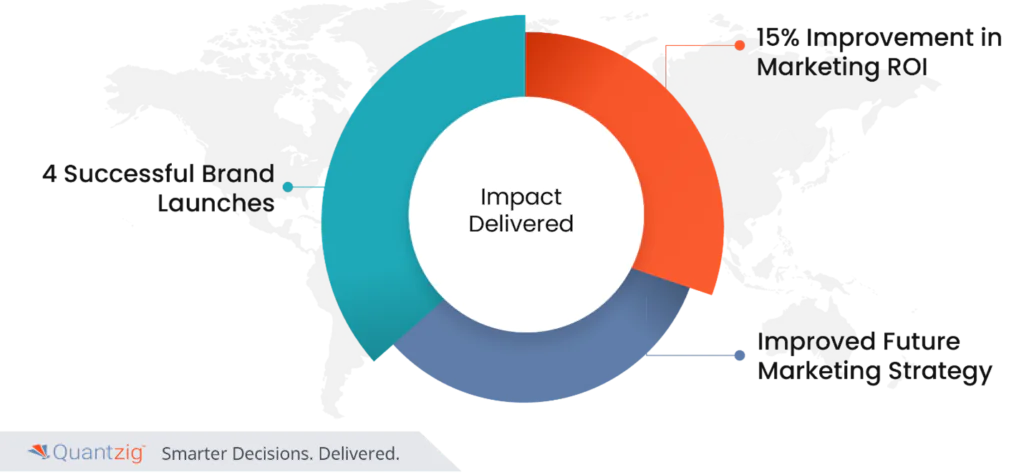
Table of Contents
Summary
- The client, a multinational F&B manufacturer based out of Europe, had recently entered into a joint venture with the world’s largest ice cream manufacturer for European Geography and Certain Brands.
- However, as a new entrant into the ice cream segment, the client wanted to understand the impact of weather on ice cream sales.
- The client had a limited budget for marketing and promotions due to just entering the segment and having multiple product launches in the pipeline.
- The client needed a solution to effectively determine the impact of weather on sales and provide recommendations on spend for current brands and brands in the pipeline.
- Quantzig identified and aggregated multiple relevant data points, including sales data, product data, promotions data, competitor data, and weather data to implement marketing re-strategizing.
- Multiple analytical models were implemented to determine the impact of weather on sales across markets and identify the roles played by promotions.
- A cross-validation framework was implemented to solidify the outcome of the analysis.
- The solution provided by Quantzig helped the client to identify the optimal time and method to spend their marketing and promotion budgets.
- The client was able to make an informed decision at the launch time and saw a significant increase in sales for their ice cream products.
Impact Delivered
- 4 successful brand launches
- 15% improvement in marketing ROI
- Improved future marketing strategy
Industry Overview
- From fast food chains to fine dining restaurants, and everything in between, the F&B industry encompasses a vast array of businesses that are always striving to stay ahead of the curve.
- With an estimated global value of over $8 trillion, the F&B industry is a dynamic and ever-evolving sector that caters to the diverse taste and preferences of consumers worldwide.
- The European Food and Beverage market is the largest in the world, with an estimated value of over 1.2 trillion Euros.
- The European Union is the world’s largest importer and exporter of food and beverages, with a total trade value of over 250 billion Euros in 2020.
- The primary driver for the growth of the F&B sector is the increasing demand for convenient and healthier food options. Consumers are increasingly conscious of their dietary choices and are seeking out foods that are both tasty and nutritious.
- With the rise of online food ordering and delivery services, as well as the use of digital menus and payment systems, technology is changing the way that F&B businesses operate with a focus on marketing re-strategizing.
About the Client
- Our client, a multinational F&B manufacturer based out of Europe with more than $1 Bn in revenue, had recently entered a joint venture with the world’s largest ice cream manufacturer for European Geography and certain brands.
- However, as a newcomer to the ice cream segment, they needed to understand how the weather could impact their ice cream sales.
- Additionally, with a limited budget for marketing and promotions, our client wanted to ensure they were making the most of their resources by identifying the most optimal time and method to spend their budgets.
- Furthermore, the client had several new ice cream products in the pipeline and needed to determine the best timeframe and method for launching them. This required a deep understanding of market trends and consumer preferences, which they hoped to achieve through data-driven insights.
Challenges Faced
- As the client had just entered the ice cream segment which led to a limited budget for marketing and promotions, he wanted to understand the optimal time and method to spend his budgets.
- The client wanted to launch multiple products in the pipeline and be sure of the timeframe and method for launch. They realized that launching products during peak demand seasons can help maximize sales but launching them during off-peak seasons may result in poor sales performance.
- Several established competitors who have a strong foothold and a loyal customer base were present in the market, making it challenging for the client to penetrate and gain market share.
- The client needed a solution that can effectively determine the impact of weather on sales and provide recommendations on spend for current brands and brands in the pipeline. They wanted to develop a introduce marketing re-strategizing that can effectively reach their target audience and generate interest and demand for their product.
- The client was looking for a data analytics company that can help them to optimize their budget allocation, launch their new ice cream products with confidence, and drive sales growth in a competitive market.
Solutions Offered
- Quantzig first identified and aggregated the multiple relevant data points like sales data, product data, promotions data, competitor data, and weather data. It provided a better understanding of their customers, competitors, and overall industry trends, leading to more informed decision-making and improved business outcomes.
- Multiple analytical models were implemented to determine the impact of weather on sales across markets and identify the roles played by promotions. It helped to understand the correlation between weather patterns and sales data and plan inventory levels, marketing campaigns, and sales strategies more effectively. Quantzig experts identified regions that experience hot weather and developed specific marketing re-strategizing to target those regions.
- Our predictive analytics model identified the roles played by promotions in driving sales during different weather conditions. For example, the client can determine whether discounts on ice cream are more effective during hot weather or rainy weather.
- A cross-validation framework was implemented to solidify the outcome of the analysis. Cross-validation is a statistical technique that helps to validate the performance and accuracy of the predictive model. In the case of determining the impact of weather on sales, cross-validation is essential to ensure the accuracy and reliability of the analysis.
- By implementing a cross-validation framework, it was possible to split the data into multiple subsets, validate the models into different subsets, and determine their performance. This helped to eliminate the risk of overfitting, where the model performs well on the training data but fails to perform on new data.
- With cross-validation, it was possible to create a robust model that accurately predicts the impact of weather on sales across markets, providing insights that can help the client make informed decisions regarding promotions and product launches. Appropriate recommendations were provided to improve product performance and launches.


